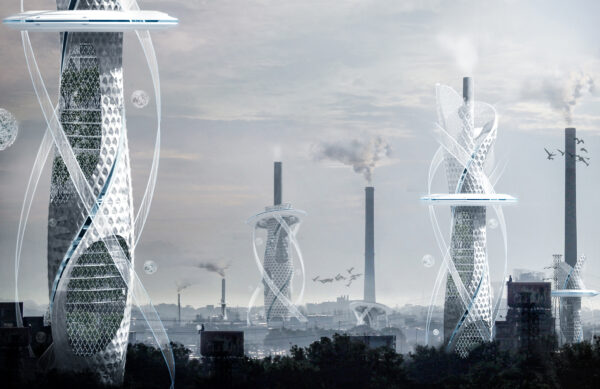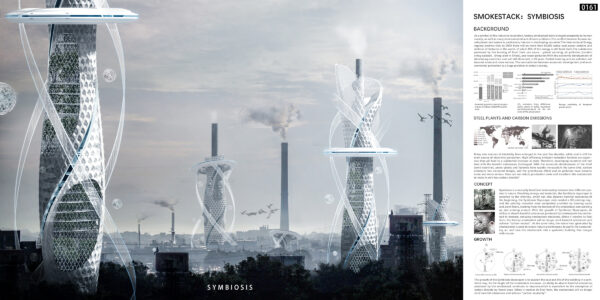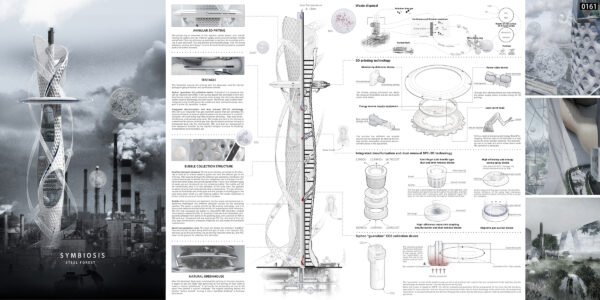Honorable Mention
2021 Skyscraper Competition
Xuekui Liu, Yashu Chen, Liyu Ai, Hao Wang, Jialu Xu
China
Economic development has changed the appearance of the earth, but also put it in misery. This triggered our thinking: Is development and the ecological environment contradictory? How to make the relationship between humans and nature become “symbiosis” instead of “parasitic”?
The historic mission of Smokestack
Starting from the invention of the steam engine, mankind slowly entered the industrial society and their life has unprecedentedly improved. As a symbol of the industrial revolution, factory smokestack has brought prosperity to human society, as well as many environmental and climate problems. The conflict between human development and nature is particularly intense in developing countries. The International Energy Agency predicts that by 2030 there will be more than 50,000 active coal power stations and millions of factories in the world, of which 85% of the energy is still fossil fuels. The substances produced by the burning of fossil fuels can cause – global warming, air pollution (London smog episode, Smog alert in China), and water pollution.
Smokestack: Symbiosis
Symbiosis is a mutually beneficial relationship between two different species in nature. Providing energy and materials, the Symbiosis skyscraper is attached to the chimney, which can also absorb harmful substances. In the beginning, the Symbiosis Skyscraper only needed a 3D printing ring, and the printing materials were completely provided by burning waste and plant fibers, starting from the bottom of the smokestack and spiraling up and printing around. With the growth of Symbiosis Skyscrapers, its ability to absorb harmful substances produced by smokestacks has continued to increase, reducing smokestack emissions. When it reaches its final form, the factory smokestack will no longer emit harmful substances and achieve “carbon neutral”. At the same time, the waste heat generated by smokestacks is used to create nature greenhouses, purify the surrounding air, and turn the smokestack into a symbiotic building that merges with nature.
Carbon neutral
The Symbiosis Skyscraper achieves “carbon neutral” through three technologies – guanidine, SPC-3D technology, and bubble collector.
Guanidine
It is a substance that can be recycled indefinitely which published in a scientific journal in 2019. It can quickly absorb CO2 and react to form tiny bicarbonate crystals, which is more advanced than the existing state-of-the-art carbon capture Technology.
SPC-3D
It is an integrated flue gas treatment system that can complete the entire purification process of desulfurization and dust removal in a cylindrical tower while achieving high desulfurization efficiency, and low operating costs.
Bubble collector
The cavity is quickly printed by 3D printing technology, and it is also called a collection bubble which will fall off automatically after collection. Compared with the traditional TPE film, this kind of film not only introduces environmental protection materials but also meets the functional requirements.
The 3D printing ring uses the fly ash from the smokestack as a building material, which connects the smokestack and the Skyscraper by printing tentacles. The pipelines inside the tentacles process carbon dioxide, sulfur dioxide, and harmful heavy metals through “guanidine, SPC-3D technology” and transport them to the “bubble collector”. The bubbles will fall off naturally after a certain degree of accumulation. All harmful substances from smokestack will not be released into the atmosphere, realizing the “carbon neutral” of the factory.
Natural greenhouse
After the Symbiosis Skyscraper completed the printing of the main structure, it began to use the waste heat generated by the burning of fossil fuels to create a “natural greenhouse”. It will purify the surrounding air and at the same time provide a natural landscape. At that time, the original polluting factory will achieve “carbon neutral”, turning it into a “symbiotic building” in harmony with nature.

















